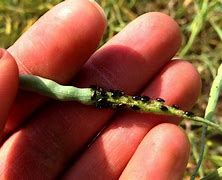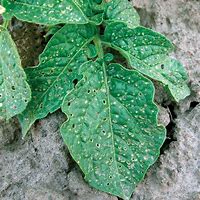The Problem
- Flea beetles are damaging to vegetable crops in both their adult and larval stages.
- An infestation of them will cause crops to be inedible and very unhealthy
 Identification
Identification
Appearance:
- The adults are very small beetles, from 1/16th to 1/4 on an inch, and dark colored — often with a metallic sheen.
- When disturbed, they tend to hop away or fly off.
Signs of damage
- Adult beetles create irregular holes that look like shotgun patterns on the leaves.
 Larvae feed on tubers and roots, causing their damage out of sight where the only indication is a plant that is weak or dying. As that’s a very non- specific symptom, it’s not a reliable indicator of flea beetles.
Larvae feed on tubers and roots, causing their damage out of sight where the only indication is a plant that is weak or dying. As that’s a very non- specific symptom, it’s not a reliable indicator of flea beetles.
Life cycle
- Understanding their life cycle is an important step in controlling them.
- Pupae spend winter below the soil.
- Adults emerge in the spring, munch on foliage, mate and deposit pale green eggs around the roots of the plants.
- The eggs hatch in 7 to 14 days.
- The destructive larval stage reaches full development in 2-4 weeks.
- After gorging themselves on roots and tubers, they pupate for 11 to 13 days.
- At that point, another generation of adults emerge to start the process all over again.
Controls
- Turning the soil after any crop is harvested disrupts the life cycle of flea beetles.
- Also ensuring the garden bed is free of overwintering weeds helps control the beetles.
- Neem oil and insecticidal soaps can be used to control the adults, but both are wide-spectrum controls and may also affect beneficial insects.
- Sticky traps can either be purchased or homemade. Again, these don’t discriminate between harmful and beneficial insects. Just sayin’.
- Beneficial nematodes attack the larvae in the soil.
- Diatomaceous earth cuts up soft-bodied insect larvae. However, it’s usually rendered ineffective by every rainfall and needs to be reapplied frequently.
- Flea beetles hate the smell of coffee grounds.

 Larvae feed on tubers and roots, causing their damage out of sight where the only indication is a plant that is weak or dying. As that’s a very non- specific symptom, it’s not a reliable indicator of flea beetles.
Larvae feed on tubers and roots, causing their damage out of sight where the only indication is a plant that is weak or dying. As that’s a very non- specific symptom, it’s not a reliable indicator of flea beetles.